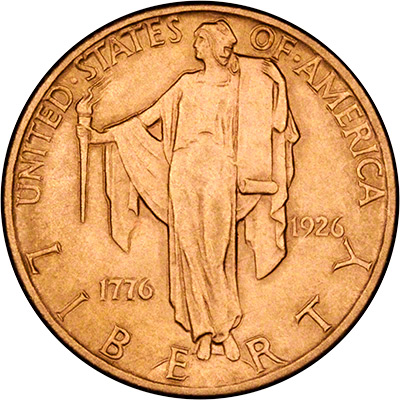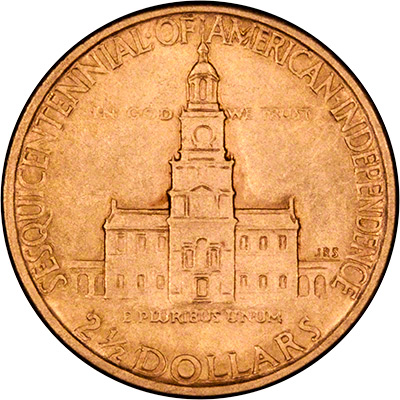|
USA Commemorative Gold $21/2 Coins
One of Only Two
The USA only issued commemorative $21/2 gold coins (eagles?), twice in its entire history.
1926 Philadelphia Sesquicentennial
In 1926, the USA issued gold commemorative two-and-a-half dollar coins for the 150th Anniversary of Independence in 1776.
The Sesqui-Centennial International Exposition of 1926 was a world's fair hosted in Philadelphia, Pennsylvania to celebrate the 150th anniversary of the signing of the United States Declaration of Independence, and the 50th anniversary of the 1876 Centennial Exposition.
The honor of hosting this celebration was awarded to Philadelphia in 1921. Initial grand plans were scaled down tremendously by the time the fair opened. The original director of the exposition, Colonel David C. Collier, resigned in protest over these budget cuts. His replacement, Captain Asher C. Baker, retired due to illness days before the festival opened, leaving things in the hands of E. L. Austin. Baker died less than two weeks later.
The senior draftsman for the design of the exposition buildings was a young Louis Kahn, later a world-renowned architect, then working under City Architect John Molitor.
The fair opened on May 31st, 1926, and ran through November on grounds bounded by 10th Street, Packer Avenue, 23rd Street, and the U.S. Navy Yard (Terminal Avenue) in South Philadelphia. Originally known as League Island Park, these grounds are now occupied by FDR Park, Marconi Plaza, Packer Park Residential Neighborhood, the four facilities of Philadelphia's massive South Philadelphia Sports Complex (Wachovia Spectrum. Wachovia Center, Lincoln Financial Field, and Citizens Bank Park), and the Philadelphia Eagles training complex which now occupy that portion of the grounds which from 1933 to 1993 were the site of Philadelphia Naval Hospital (demolished 2001).
Organizers constructed an 80 foot replica of the Exposition's symbol, the Liberty Bell, covered in 26,000 light bulbs, at the gateway to the festival. Sesqui-Centennial Stadium (later known as Philadelphia Municipal Stadium, and after 1964, John F. Kennedy Stadium) was built in conjunction with the fair. Also on display at the exposition was the Curtis Organ, still one of the largest pipe organs in the world. In 1926 the first bridge (later renamed Benjamin Franklin Bridge) spanning the Delaware River between center city Philadelphia and Camden, New Jersey, was built in anticipation of the attending crowds.
Key speakers at the opening ceremonies were Secretary of State Frank B. Kellogg, Secretary of Commerce and future President Herbert Hoover, and Philadelphia Mayor W. Freeland Kendrick.
The fair drew a much smaller crowd than anticipated (about 10 million people). It ended up unable to cover its debts and was placed into receivership in 1927, at which point its assets were sold at auction.
A gold commemorative $21/2 was issued to commemorate the event.
Description
This souvenir gold commemorative was struck for the 1926 Sesqui Centennial Exposition held in Philadelphia to commemorate the 150th anniversary of American independence.
The obverse shows Liberty standing, wearing a gown, with a large torch in her right hand and with drapery over her left shoulder and right forearm. A close-fitting cloth cap is on her head. In her left hand is a scroll said to represent the Declaration of Independence but not of the correct proportions of this famous document.
The reverse shows Independence Hall in Philadelphia. There is a feature in the field that represents rays of the sun; this characteristic is not distinct on all pieces. Nearly all 1926 Sesqui quarter eagles in existence today show evidence of handling and contact from careless production at the Mint and from later indifference by the public who bought them. This was the second and final U.S. commemorative gold coin of this denomination.
Technical Specifications
|
Denomination | Diameter | Weight | Fineness | Gold Content
| |
2.5 Dollars | 18 | 4.1800 | .900 | 0.1210
|
Notes on Table
Diameter = Diameter in millimetres.
Weight = Gross weight in grams.
Fineness = purity of gold alloy.
Gold Content = Actual gold content in troy ounces.
Price & Availability
Please contact us prior to ordering for current prices and availability.
|
Date | Type | Mintage | Description | Available | Price £ | Price $
| |
1926 | Philadephia Sesquicentennial | 46,019 | About Uncirculated | Yes | £250 | $495
|
Prices Subject to Fluctuation
Please note all rates, both percentage premiums and actual prices, fluctuate.
We have attempted to give an accurate indication of our current prices as at the last update of this page.
Please check current prices and availability before ordering.
Why don't we update our prices daily?
Please check our Standard Terms for Bullion Coins.
You may wish to use our Order Form UK
Order Form USA.
Postage & Packing
UK Registered Post (Special Delivery) £9 per order
EU Insured Post £10 per order
USA Airmail $10, Insured Shipping $20
Canada Airmail $15, Insured Shipping $30
|
|

Obverse of 1926 USA Philadephia Sesquicentennial $21/2 Gold Coin
USA
Countries Index

Reverse of 1926 USA Philadephia Sesquicentennial $21/2 Gold Coin
|


